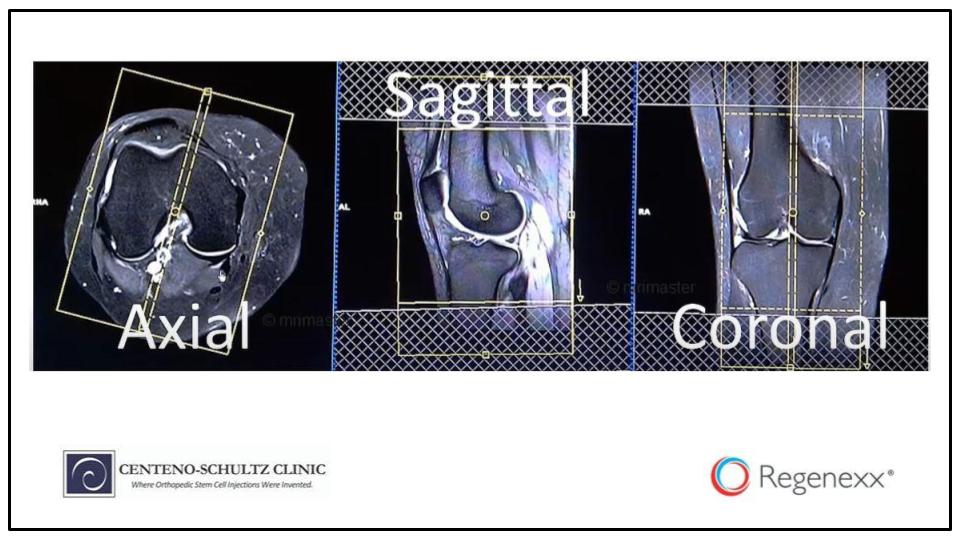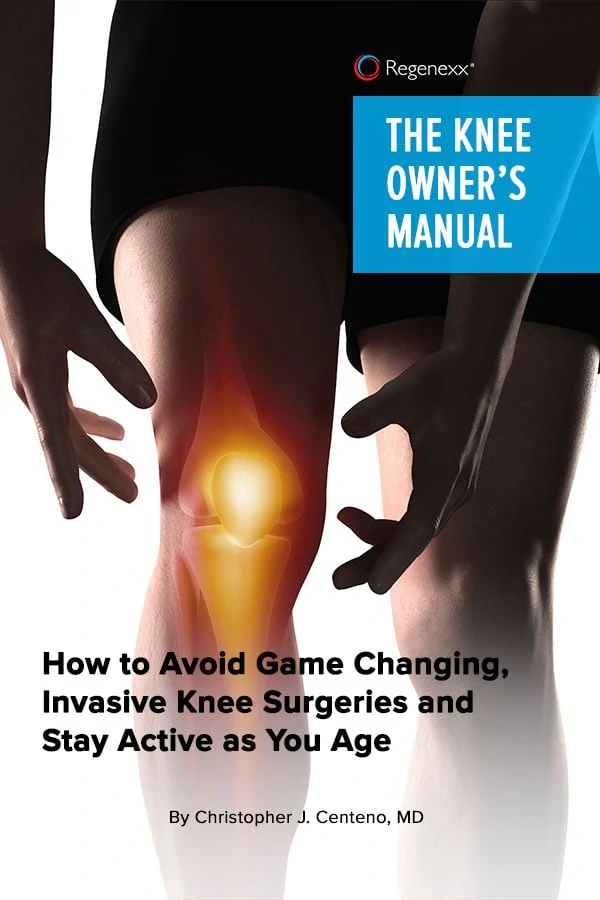Transcript for “How to Read Knee MRI”
Hi, this is Dr. Centeno and I’d like to go over how to read knee MRI. I got the idea for this when a friend had a knee injury, got an MRI, was sent home with the CD, and just jumped on the internet to try to figure out how to read it. I’m sure there’s a lot of people that do that. So my goal here today is not to teach somebody how to become a radiology expert or how to read more information off their MRI than they might get from a doctor’s opinion or a radiologist reading, but just to give you some idea about what to look at and to educate you about your knee.
So, an MRI is a 3D picture that slices through the knee in three planes; sagittal, coronal, and axial. And if you look at that, the sagittal plane as shown here is a “saw you in half” view from the side, so sort of a side view. The axial plane is a traditional “saw you in half” type view. And the coronal plane is from the front. So for a knee MRI, an axial view would look like this off to the left here, a sagittal view like this, and a coronal view like that. So again, top-down on axial, sagittal from the side, coronal from the front.
And again, as you look through an MRI, you have to understand that you’re looking at slices of an image. So you have to get a sense that you’re looking from front to back or left to right, and you’re looking at individual slices as you march across the structure.
This is what a knee looks like, so the major structures. You have the femur bone up top. We have cartilage on the end of that femur bone and on the top of the tibia bone. We’ve got the knee meniscus which acts as a shock absorber. There are the middle ligaments, the ACL and PCL, and then the side ligaments, and then the kneecap or patella. So those are the major structures that we’ll look at today.
So now let’s read an image. I’m going to just click out of this for a second here. This is a patient who actually allowed her image to be used for this so I want to give her credit for allowing me to do that. So, you see here, I’m in the MRI program. Up here, you can see that we have different types of images. And there are different types of MRI programs, but here we have an axial image and then a side image and then some front images.
So let’s start with, and I’m going to drag this down here, one of the coronal or front images. And it starts from the front. I’m going to just quickly march through the whole thing here to the middle. And that’s about the middle of this image. So what do we see here? We see up top the femur bone, on the bottom the tibia bone. And this little dark triangle in here and this triangle out here, those are the meniscus. These are the shock absorbers, and they look like this dark little triangle on both types of images.
And so what do you notice here? You can also see the grey. You’ve got this darker color here, which is the bone. And then the lighter color, which is the cartilage on the very end. Now, realize there are two kinds of front or coronal images here. This one where water is bright, also called a fat sat. And then I’m going to go to this one where the bone is light now. The cartilage is dark. The meniscus is about that same dark color.
So let’s read a little bit here. I go back to this other image and we just focus right here on this meniscus. If I blow this up a little bit, it’s a bit bigger than that. I’m going to see here that this triangle right here is the meniscus. This is the inside meniscus, that’s the outside meniscus.
As I march through, I want you to focus right here. And we’re going to see that this meniscus has a little white area in it, and this meniscus remains dark. This is the inside or medial meniscus. This is the outside or lateral meniscus. The inside meniscus has a little white area in it, and that’s a tear. You can see that you don’t see that in the lateral meniscus. You can also see that this gray cartilage layer here looks a little rutty, meaning it isn’t uniform in how grey it is, which indicates some problems in the cartilage. In the middle here, you’re seeing the ACL ligament as I scroll through these. Out here, the fibula, and that’s how you know it’s the lateral or the outside. So, that’s the front image. In this particular patient, she has a little benign tumor in the bone here, which is what this is. That’s the front image.
In continuing on how to read Knee MRI, now let’s look at the side image just to give you a quick sense of that. On the side image as we march across, this one starts from the inside to the outside. We see some of the pes anserine tendons coming across here. And we see a lot of this white stuff. This white stuff in this darker fat sat type sequence is fluid. This is a swelling or this is a fusion around the inside of the knee.
We also see the meniscus. These triangles are the meniscus. This is the back meniscus. This is the front meniscus on the inside. And again, you can see this light color in the meniscus, which indicates that there’s a bit of a tear.
As we go towards the very middle, you’re going to see more fluid in the back. This would be defined as a Baker’s cyst. And as we go through the middle, you’re going to start to pick up the middle or midline ligaments. You’re going to see the patella upfront or the knee cap. This is the kneecap tendon. You’re going to see this is the PCL or the posterior cruciate ligament. Next, you’re going to see the ACL as we go across, or the anterior cruciate ligament going at this 45 degree angle. And you see cartilage on the end of the bone here, this light stuff. As we go over to the lateral side, we’re going to start to pick up the meniscus again, these triangles. And again, we see those triangles right there coming in. We see the light stuff on the end which is the cartilage. The dark area, which is the bone. And then eventually, we’ll pick up the fibula bone.
And now, we’ll finish up with just a quick look at the top-down or the axial view. Now, the top-down or the axial view, one of the first things we noticed as we go through it, is we have up top here, the kneecap. The kneecap sits in a groove. And really for your purposes, that’s really the only thing that’s going to be important about this image.
Now, this particular patient has a very shallow groove. Your groove is probably deeper than this, but this patient has a very shallow groove so this kneecap doesn’t sit in a really firm groove, and it’s probably going to move around a lot on this patient. You’re going to see here the lighter bone in this particular sequence and then the darker cartilage.
So I think we’ll end there for right now. That’s just a quick overview of how to look at your MRI and some information on how to read Knee MRI, and what structures you’re looking at. If you have any other needs or information that you want, I would go to regenexx.com. And thanks for listening today.

